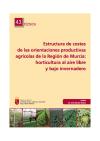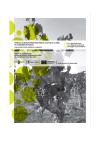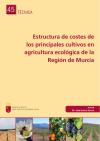Media library
Documentary, graphic and/or audiovisual knowledge objects are offered here, offering information on various sectors and topics. Use the keyword search or search filters to access current audiovisual and documentary knowledge objects useful for your implementation.
If you have any questions or suggestions, please contact us here.

Cost structure of agricultural production areas in the Region of Murcia: stone fruit and citrus fruits
Publication dedicated to the cultivation of regional citrus and stone fruit trees

Cost structure of the agricultural production guidelines of the Region of Murcia: nuts, pome fruit, vines, and olives
Publication dedicated to the most characteristic woody crops of rural Murcia, including nuts, pome fruit, table and wine grapes, and olive trees.

Cost structure of agricultural production areas in the Region of Murcia: open-air and greenhouse horticulture
Publication dedicated to regional horticultural crops, both outdoors and under protected and greenhouse conditions.

Manual of good practices for vine cultivation in the region of Murcia. Socioeconomic and environmental assessment
The manual aims to convey, in a direct and simple way, to winegrowers and technicians involved in the regional wine chain, sustainable cultivation guidelines, both for dryland bush-fed vines and for irrigated trellis vines.

Cost structure of the main crops in organic farming in the Region of Murcia
Document describing the main guidelines for regional organic farming in Murcia

Field notebook for the recognition of possible ozone symptoms in sustainable crops
Field notebook for the recognition of ozone symptoms in crops
Climate change adaptation strategies for extensive livestock farming in Spain: a social perspective
Extensive livestock farming is a centuries-old activity throughout the Iberian Peninsula. Beyond being an economic sector within the agricultural sector, this activity provides society as a whole with key ecosystem services, including food provision, ecosystem regulation, the provision of cultural goods, the shaping of rural and mountainous landscapes, and fire prevention in forested areas.
Avian Influenza Biosecurity Standards
Basic biosecurity standards for the prevention of avian influenza
Surveillance and control program for Salmonella serotypes of public health importance in poultry farms in Andalusia
Salmonellosis is a disease of humans and animals caused by microorganisms of the Salmonella genus belonging to the Enterobacteriaceae family. This family is composed of many serotypes. Not all serotypes are important in animal health, as some do not cause disease in animals. However, they are important in public health because they are the cause of one of the main foodborne illnesses.
Newcastle Disease Surveillance Program in Domestic Poultry 2024
Newcastle disease virus (NDV) belongs to the Paramyxoviridae family in the Avulavirus genus. There are ten avian paramyxovirus serotypes designated APMV-1 to APMV-10, and the Newcastle disease virus has been designated APMV-1.
Avian Influence Surveillance Program in Domestic Poultry
Avian influenza (AI) is a highly contagious and extremely variable infection of poultry and wild birds, the latter acting as a natural reservoir. Disease can range from moderate to severe, but only the H5 or H7 subtypes cause Highly Pathogenic Avian Influenza (HPAI), the most severe strain. These are extremely contagious and virulent strains, causing high mortality in poultry.
Avian flu: information brochure
Avian influenza (bird flu) is a disease caused by a virus that can affect most birds, both domestic and wild. This virus can also cause illness in humans. In 2003, an outbreak began in Southeast Asia and has gradually spread to other parts of that continent, as well as to Europe and Africa.
Health Surveillance Program for Pigs
The Spanish pig sector is the main livestock sector in our country, and is among the leading producers in Europe and worldwide. Its stability depends largely, and increasingly each year, on the level of exports of live animals and their products to other Member States and third countries.
Aujeszky's disease. Disease control and epidemiological situation.
Aujeszky's disease, also known as swine pseudorabies, is an infectious disease caused by a herpesvirus that infects the central nervous system and other organs, such as the respiratory tract, in many mammals (such as dogs, cats, cattle, rabbits, foxes, minks, etc.) except in humans and tailless monkeys, with the pig species being particularly important from a health and economic point of v
Contingency plan for suspected and confirmed sheep and goat pox in Andalusia
Sheep and goat pox is an infectious disease caused by a DNA virus belonging to the Capripoxvirus genus within the Poxviridae family. It produces a clinical picture in sheep and goats characterized by the appearance of fever, generalized nodules and papules, rarely vesicles, internal lesions particularly in the lungs, and, ultimately, death.
Manual on national plans for the eradication of animal diseases in Andalusia
Manual for the eradication of ruminant diseases
Caprine tuberculosis control program
Tuberculosis is a chronic, contagious, infectious disease that suppresses the immune system, leading to the onset of other illnesses, loss of production, and trade restrictions, including restrictions on participation in auctions and competitions. It affects all domestic animals, some wild animals, and humans, and is therefore classified as a zoonosis.
Swine Biosecurity Triptych
Decalogue of biosecurity in pig farms
National Bovine Tuberculosis Eradication Program in Andalusia
The territorial scope of this program is the Autonomous Community of Andalusia, which, according to the national program, is included among those autonomous communities with a herd prevalence rate greater than 1% or "high prevalence."
National Contingency Plan against Trichina
Trichinosis is a parasitic disease that affects humans and numerous host species, mainly wild and domestic mammals, caused by various species of the genus Trichinella.



